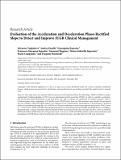| dc.contributor.author | Tagliaferri, Salvatore | |
| dc.contributor.author | Fanelli, Andrea | |
| dc.contributor.author | Esposito, Giuseppina | |
| dc.contributor.author | Esposito, Francesca Giovanna | |
| dc.contributor.author | Magenes, Giovanni | |
| dc.contributor.author | Signorini, Maria Gabriella | |
| dc.contributor.author | Campanile, Marta | |
| dc.contributor.author | Martinelli, Pasquale | |
| dc.date.accessioned | 2016-05-09T16:44:03Z | |
| dc.date.available | 2016-05-09T16:44:03Z | |
| dc.date.issued | 2015 | |
| dc.date.submitted | 2015-11 | |
| dc.identifier.issn | 1748-670X | |
| dc.identifier.issn | 1748-6718 | |
| dc.identifier.uri | http://hdl.handle.net/1721.1/102439 | |
| dc.description.abstract | Objective. This study used a new method called Acceleration (or Deceleration) Phase-Rectified Slope, APRS (or DPRS) to analyze computerized Cardiotocographic (cCTG) traces in intrauterine growth restriction (IUGR), in order to calculate acceleration- and deceleration-related fluctuations of the fetal heart rate, and to enhance the prediction of neonatal outcome. Method. Cardiotocograms from a population of 59 healthy and 61 IUGR fetuses from the 30th gestation week matched for gestational age were included. APRS and DPRS analysis was compared to the standard linear and nonlinear cCTG parameters. Statistical analysis was performed through the t-test, ANOVA test, Pearson correlation test and receiver operator characteristic (ROC) curves (p < 0, 05). Results. APRS and DPRS showed high performance to discriminate between Healthy and IUGR fetuses, according to gestational week. A linear correlation with the fetal pH at birth was found in IUGR. The area under the ROC curve was 0.865 for APRS and 0.900 for DPRS before the 34th gestation week. Conclusions. APRS and DPRS could be useful in the identification and management of IUGR fetuses and in the prediction of the neonatal outcome, especially before the 34th week of gestation. | en_US |
| dc.publisher | Hindawi Publishing Corporation | en_US |
| dc.relation.isversionof | http://dx.doi.org/10.1155/2015/236896 | en_US |
| dc.rights | Creative Commons Attribution | en_US |
| dc.rights.uri | http://creativecommons.org/licenses/by/2.0 | en_US |
| dc.source | Hindawi Publishing Corporation | en_US |
| dc.title | Evaluation of the Acceleration and Deceleration Phase-Rectified Slope to Detect and Improve IUGR Clinical Management | en_US |
| dc.type | Article | en_US |
| dc.identifier.citation | Tagliaferri, Salvatore, Andrea Fanelli, Giuseppina Esposito, Francesca Giovanna Esposito, Giovanni Magenes, Maria Gabriella Signorini, Marta Campanile, and Pasquale Martinelli. “Evaluation of the Acceleration and Deceleration Phase-Rectified Slope to Detect and Improve IUGR Clinical Management.” Computational and Mathematical Methods in Medicine 2015 (2015): 1–9. | en_US |
| dc.contributor.department | Massachusetts Institute of Technology. Research Laboratory of Electronics | en_US |
| dc.contributor.mitauthor | Fanelli, Andrea | en_US |
| dc.relation.journal | Computational and Mathematical Methods in Medicine | en_US |
| dc.eprint.version | Final published version | en_US |
| dc.type.uri | http://purl.org/eprint/type/JournalArticle | en_US |
| eprint.status | http://purl.org/eprint/status/PeerReviewed | en_US |
| dc.date.updated | 2016-05-08T09:30:28Z | |
| dc.language.rfc3066 | en | |
| dc.rights.holder | Copyright © 2015 Salvatore Tagliaferri et al. This is an open access article distributed under the Creative Commons Attribution License, which permits unrestricted use, distribution, and reproduction in any medium, provided the original work is properly cited. | |
| dspace.orderedauthors | Tagliaferri, Salvatore; Fanelli, Andrea; Esposito, Giuseppina; Esposito, Francesca Giovanna; Magenes, Giovanni; Signorini, Maria Gabriella; Campanile, Marta; Martinelli, Pasquale | en_US |
| dc.identifier.orcid | https://orcid.org/0000-0001-9876-9050 | |
| mit.license | PUBLISHER_CC | en_US |
